|
Our film
begins in Austin, Texas, where Officer
Ramiro Martinez (Richard Yniguez)
returns to the police station when his
overnight shift comes to an end. Even with
the sunrise still hours away the Texas
heat is already sweltering, and before he
heads back into the soup and home, when
Martinez is informed by Lt. Lee (Pernell
Roberts) that he's been passed over
for promotion -- again, there are less
than subtle hints that less than subtle
racism is the reason why. Meanwhile,
elsewhere in the city, Charles Whitman (Kurt
Russell), an ex-Marine
sharp-shooter strung out on amphetamines (--
though the movie neglects this aspect),
composes a type-written letter about some strange and
violent thoughts he's been having lately
that he has no explanation for. He also
plans to act out on these thoughts. He's
already killed his mother and put her to
bed. (Whitman bludgeoned her from
behind but the script deviates here.)
Then, after he ambushes and kills his wife (--
but he really killed her while she slept), Whitman adds an amendment
to his letter, confessing to these heinous
acts, and promises that this is only the
beginning...
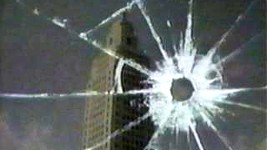
On
Monday, August 6th, 1966 America, still
recovering
from the despicable murderous acts of
Richard Speck in Chicago
the week prior, was walloped again on this
fateful day. For on that day, a little
before noon, Charles Whitman started
shooting from the observation
deck of the University Tower in Austin,
Texas. Ninety-six
minutes later, twelve people were dead and
countless others wounded. Also killed
prior to the rampage were Whitman's wife
and mother. And Whitman was dead, too;
dropped in a hail of gunfire and buckshot
-- just like he probably wanted. The prick.
In an hour and half America was changed
forever. These days we make jokes about
people going postal, but this was one of
the first, and still ranks as one of the
worst, cases of mass murder in U.S. history.
And it happened during the light of day,
out in the open, where we would never feel
quite as safe again.
 Why
did he do it? We'll get to that in a
second. For now, we're gonna take a
look at the only attempt that I'm aware of
to bring the story of that ill-fated day
to film: a made for TV movie called The
Deadly Tower
-- and yes, I'm well aware of Peter
Bogdanovich's Targets, an
excellent, thinly veiled version of the
story that drew its inspiration from this
incident, but I'm talking about an actual
account of the actual day in question. Seldom
seen anymore, this rarity used to be a
late night staple on TBS and was
also released on VHS video under the
alternate title, Sniper.
I finally managed to get my hands on a
very beat-up copy that was basically
unwatchable for the first half-hour, and
then "almost" tracked for the
remaining hour -- alas,
my first negative feedback experience on eBay.
I was just gonna let it go but when about
ten minutes of the film went missing,
taped over with something else, was
ultimately the deciding factor. Why
did he do it? We'll get to that in a
second. For now, we're gonna take a
look at the only attempt that I'm aware of
to bring the story of that ill-fated day
to film: a made for TV movie called The
Deadly Tower
-- and yes, I'm well aware of Peter
Bogdanovich's Targets, an
excellent, thinly veiled version of the
story that drew its inspiration from this
incident, but I'm talking about an actual
account of the actual day in question. Seldom
seen anymore, this rarity used to be a
late night staple on TBS and was
also released on VHS video under the
alternate title, Sniper.
I finally managed to get my hands on a
very beat-up copy that was basically
unwatchable for the first half-hour, and
then "almost" tracked for the
remaining hour -- alas,
my first negative feedback experience on eBay.
I was just gonna let it go but when about
ten minutes of the film went missing,
taped over with something else, was
ultimately the deciding factor.
The
production does, forgive me, shoot for
accuracy but, being a made for TV movie,
was under some restraints. The Deadly
Tower does manage to sidestep some of
these prickly issues by focusing not only
on Whitman but on one of the heroes of
that day: Officer Martinez, and
used him as a framing device to
counterbalance Whitman's activities prior
to the shootings, and then focuses on the
deadly game of cat and mouse they engage
in after the shooting starts.
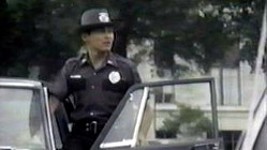
But,
we're getting ahead of ourselves again as
we pick up the action the following
morning, where we find Martinez trying and
failing to enjoy his day off. Upset about
the promotions, he takes it out on his
wife, Vinnie (Maria Cordero),
who senses his frustrations. But when she
tries to help it only results in a bigger
argument over whether he should just quit
the force altogether. Whitman, meanwhile,
is hitting all the local gun shops, buying
rifles and a lot of ammunition. You'd
think this would send up a red flag but we
are talking about Texas. (And yes,
that was a cheap shot. It wouldn't raise
any red flags around here, either.)
When the clerk asks what Whitman's hunting
for his answer is simple: "Gonna
shoot some pigs." We
then cut to Whitman meticulously packing
all of these weapons into a footlocker,
along with some food, water and a portable
radio. Donning a janitor's jumpsuit, he
then loads the trunk onto his truck and
drives to the UT campus, where he wheels
the hidden cache toward the Administration
Building and his final destination: the
observation deck on the 29th floor of the
University Tower.
The
unassuming Whitman easily rolls his deadly
cargo right by security and into an
elevator. Upon reaching the top floor he's
finally stopped by a secretary, who wants
to know what he's up to. Caught, Whitman
threatens that if she values her life,
she'd best leave and escorts her to the
elevator. (In reality, Whitman
bludgeons her to death, too.)
Whitman then hauls the trunk onto the open-air deck that surrounds the building and
starts unloading his arsenal ... Down
below, the frightened secretary alerts the
campus security chief, who dispatches two
unarmed guards to investigate. They spy
Whitman and all his guns, and after reporting
in the chief orders them back down to the
lobby to seal off the elevators so no one
else can get up there. But they're already
too late: another elevator filled with a
family of tourists was on its way up as
they're heading down. Making their way to the
observation deck, Whitman hears them,
grabs his shotgun, and then the killing
begins in earnest.
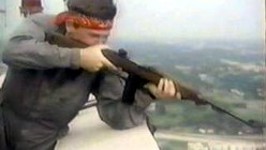
Whitman
ambushes the group in the stairwell,
killing two and critically injuring two
more. The others retreat and are pulled
into some adjoining offices by others who
heard the shots, where they hide, unsure
of what's really going on. Returning to
the deck, the shooter takes up his rifle
and peers through the high-powered scope
at the people milling about below ...
Slowly he moves, from one person to
another, before settling on a target and
starts firing. First hit is Claire Wilson,
who is shot in the lower abdomen. She was
over 8-months pregnant. (Wilson
lost her baby but survived.)
Her friend, Thomas Eckman, turned to help,
but was hit next and died instantly,
falling on top of her. (As the
shootings contiuned, Whitman
would use the wounded and the dead by firing at those
trying to help them.) Moving around
the tower, shooting in all directions,
Whitman's massacre continues. As the
campus erupts in panic, people scramble
for cover. Incredulous onlookers several
blocks away -- an assumed safe distance,
are hit, too. It seems no where is safe.
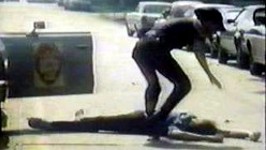
Ramirez
hears the initial reports over the radio
and, despite his wife's protests, heads to
the campus to help, where Captain Ambrose (Clifton
James) tries to get a lock on the
situation and worries about all the media
attention. A command post is quickly set
up but there is no real plan on what they
should do beyond that. This kind of thing
isn't really in the handbook. A Detective
Forbes (John Forsythe) asks
permission to leave, feeling he can do
more good trying to figure out who it is
that's up there shooting, and then maybe
they can find someone to talk him down.
Ambrose gives him the OK, but warns that
if they have the opportunity they will
shoot first and sort it out later. Beyond
that, due to the chaos of the situation --
officers are scattered everywhere, and the
phone lines are jammed up -- there is no
coordinated plan of attack. Ramirez
arrives on scene and runs into Officer
Davis (Alan Vint), who
brings him up to speed. Their biggest
problem is that the sniper can reach them
but he is effectively out of their range.
But that doesn't stop a lot of locals from
arming themselves with their own guns and
firing back at the tower. Ambrose is even
desperate enough to OK the use of
crop-duster, to try and buzz the tower and
see if they can get a clear shot at the
sniper.
Up
above, Whitman takes a breather, turns on
his radio and listens to the reports of
the mayhem he's caused. He freaks a little when
he can't get the scuff marks off his
polished boots, so he starts shooting
again.
And while the bodies keep piling up,
Ramirez helps round-up some of the wounded
but soon realizes it's a futile gesture if
the shooting doesn't stop. With that, he
decides to try and make it into the tower
-- a daunting task because there is a lot
of open ground between him and the
entrance. Meanwhile, Officer C.T. Foss (Paul
Carr) is also trying to make his
way to the Tower and makes it as far as
the campus bookstore, where he runs into
Allan Crum (Ned Beatty).
Foss tells Crum, a civilian, to keep
himself and his rifle out of trouble until
Crum reveals that he can get them into the
tower safely, via some connecting tunnels
under the buildings.
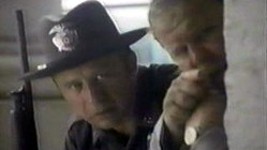
Elsewhere,
while
canvassing the gun shops, Detective Forbes
begins to piece it all together. He gets Whitman's
name from the receipts, which eventually
leads him to the discovery of Margaret and
Kathy Whitman's bodies and her husband's
letter ... Things are starting to close in
on our boy on the observation deck as
well. The bi-plane
is a bust but heavier caliber weapons, mostly
civilian, are starting to reach Whitman's
perch. Unfortunately, they also prove just
as deadly to those innocent victims trying
to hide inside the building upper levels.
Safely inside below, Foss and Crum watch
as Martinez zigzags his way through the
open quad, dodging bullets, making it
safely out of Whitman's line of fire.
Congregating in the lobby with Davis and
few others who made it in using a utility
tunnel, the officers argue over what to do
next. Martinez wants to try and contract
Ambrose for orders, and to let them know
they made it inside, while the others just
want to head on up and end this. In the
end they try to contact the command post
but the phones are still jammed up --
meaning they're on their own.
Cautiously
entering the top floor, the officers first
start clearing out the rooms just below
the observation deck and escort those
found alive and the wounded back down to
the lobby. While they search, Crum laments
to Martinez that he's proud of his
hometown, but now, everyone around the
country is going to think they're all a
bunch of crazed killers -- and he'll never
be able to look at the tower the same way
again. Once the top floor is cleared,
while the others secure the area, Martinez
and Crum make their way up the stairwell
to the door of the observation deck.
Outside, the shooting has stopped so they
don't know where Whitman is. Before they
try the door, when Crum asks Martinez to
deputize him Martinez laughs. He thought
Crum was a cop. Told to raise his right
hand, after he does, Martinez says "Consider
yourself deputized." With that
out of the way, Martinez tries the door
but it's jammed shut by Whitman's
two-wheeled cart. Forcing it open, the
metal dolly clangs on the cement, alerting
Whitman to their presence. As they vigilantly
make their way outside Whitman is
nowhere to be seen. With no clue to where
the shooter is, Martinez leaves Crum by
the door and starts to creep along the
wall toward the first corner. He
quietly rounds it and finds nothing.
Suddenly, a gun appears in frame behind him, but it's only
Foss, whom Ramirez grabs before the people
on the ground can shoot him, mistaking him
for the sniper. On the other side of the
building, Whitman listens. His radio is
still playing and a report comes on
listing those who've been killed. As the
shooter listens, sweating, and shaking, he
then let's out a blood-curdling scream.
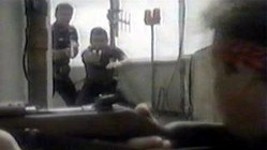
The
killer's position given away, Martinez and
Foss quickly round the next corner, where
Whitman sits and waits. When Martinez orders
him to drop the rifle, he doesn't, and
swings it around to fire at them. Foss freezes but
Martinez empties his revolver into
Whitman, and then takes the shotgun away
from Foss to finish the job but Whitman is
already dead. When the officers try to
approach the body to be sure, their
movement draws more fire from below.
Waving a white handkerchief, Crum yells at
them to stop shooting. It's finally over.
Then, all is silent except for the
newscaster, who is still listing the
wounded. Crum angrily takes the radio and
smashes it.
Down
below, Forbes returns too late with the
Whitman family priest. Up above, the
police photograph and catalogue Whitman's
arsenal. Martinez, overcome by the
situation, succumbs to shock and is
escorted out of the building and into the
waiting embrace of his wife, who wandered
down because she was worried about him. The
film then ends with our good friend, the
overly morose narrator, who says an
autopsy on Whitman found a malignant brain
tumor that some doctors believe was the
cause of his homicidal behavior. He also
cites that Martinez, Foss, Davis and Crum
were all given medals for their actions
that day.
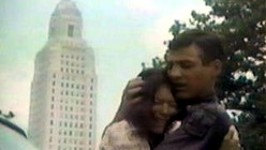
The
End
I
honestly believe, as an art form of
entertainment, the Made for TV movie is
all but dead. Well, if not dead breathing
its last lethargic gasps as a
Sci-Fi Channel or Lifetime Original
Production. Tragically, all we can do is
hearken back to the glorious heydays of
this convention in the 1970s, where
anything and everything -- sentient
homicidal bulldozers, psychic
occult detectives, and ancient
spirits of evil hijacking airplanes --
wound up as a televised movie of the week
on one of the Big-Three broadcasting
channel. *sigh*
Made
eleven years after Whitman's reign of
terror, The Deadly Tower was shot
at the state capitol building in Baton
Rouge, Louisiana because Austin really
didn't want any part of it -- or needed
any reminder of their unlucky role in this
infamous piece of American history.
Directed by Jerry Jameson, he also helmed
several other MFTV-movies including a
couple of pretty good disaster tubers,
with Heatwave
and A
Fire in the Sky.
He also had a hand in the feature film
disasters, Airport
'77
and Raise
the Titanic.
William Douglas Lansford provided the
teleplay but is probably more famous for
another MFTV-movie he wrote called Sweet
Hostage.
That's the one where Martin Sheen plays
the escaped mental patient who kidnaps
young Linda Blair, who eventually fall in
love, thanks to some really bad poetry. And
like all MFTV-movies from the '70s, The
Deadly Tower
was populated by a ton of B-level
character clout with the likes of Roberts,
Forsythe, Beatty, and the wonderfully
acerbic Clifton James. And I'm guessing
Russell really wanted to break away from
his Dexter Riley character -- from all
those goofy teenage Disney movies he made
-- because he went from The
Strongest Man in the World
to this. (And
Used
Cars
after that, and then John Carpenter got a
hold of him for Elvis
and
the rest is cinematic history...) And
to his credit, his portrayal of Whitman as
a meticulous cipher really does elevate
the production a couple of notches.
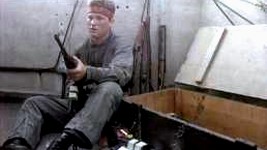
Like
I pointed out, numerous times, the
production wasn't completely accurate, but
it does do a good job of translating the
chaos and confusion during the rampage.
The camerawork -- especially the handheld
stuff -- is fantastic, so kudos to
cinematographer Matthew Leonetti. The most
glaring and unforgivable mistake the film
makes is the complete exclusion of Officer
Houston McCoy (-- the Foss
character substitutes for him).
McCoy was the other officer with Martinez
and Crum who made it into the tower and
took Whitman out. In fact, there is much
debate as to who really shot Whitman -- a
source of bitter contention between the
two men. Martinez
claims that he emptied his revolver into
Whitman, and then took the shotgun away
from McCoy and used it to shoot Whitman
again, who was allegedly still moving.
McCoy, meanwhile, claims he fired the
shotgun twice before Ramirez took it away,
and he was the one who really killed
Whitman. Regardless, they did get him
before he could do even more damage. For
the record: Martinez and McCoy both sued
the production for all these inaccuracies.
Martinez settled out of court, but McCoy
lost his case.
Of
course by focusing more on the good guys,
the film never really gets to the most
important factor: Why did Whitman do it?
There is some mention of the small tumor
found during the autopsy, but no on can
agree if it had any affect on his behavior
or not. Researchers and biographers try to
point to one thing that caused it: To
either get back at his abusive father --
and that's why he killed his wife and
mother, so only the father would answer
for his son's crime; he was strung out on
amphetamines; or overwhelming feelings of
failure and inadequacy, or perhaps some
deep-seeded narcissistic tendencies, drove
him to do something so drastic that
everyone would know and remember who he
was.
I
vote for all of the above.
I'm
always baffled as to why people --
especially the morons in the media -- want
to boil the cause of these tragedies down
to just one thing. One thing? That's over
simplifying and, like I said, a moronic
way of thinking. Sometimes the answers are
so simple we just can't see them for their
obviousness, or refuse to see them. Other
times it's a little more complicated. But
who wants complicated when we can just
blame it all on [insert your own favorite
scapegoat here]. And as always, these
debates rage only after the tragedy has
occurred, then return to a slow slimmer
until the next whack-job pops off. And
also, as usual, those of us not directly
affected by the attack only remember
Whitman. The prick. To help rectify that
I've also listed the names of the victims
over to the left in the sidebar; the the
true characters in all of this.
With
plenty of scenery chewing, enough
melodrama to choke a moose, one really bad
attempt at comedy relief at the end, and
more than a few historical inaccuracies, The
Deadly Tower
is a rather fine example of the 1970's
Made for TV-docudrama. And thankfully, it
didn't make the critical mistake
of trying to make Whitman into some kind
of victim or ersatz folk hero. He was --
despite whatever rationale caused him to
pull the trigger, or how many guns he had
-- a very ruthless and methodical killer
whose victims didn't know what hit them.
That's it. And no amount of
psychoanalysis, or Harry Chapin ballads,
or any kind of Nietzchien justification
bullshit is gonna change that fact.
Rot
in hell, Chuckles.
|